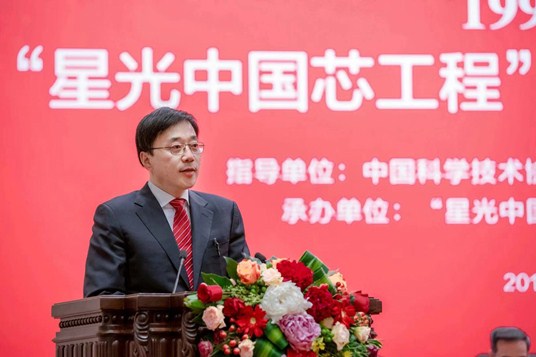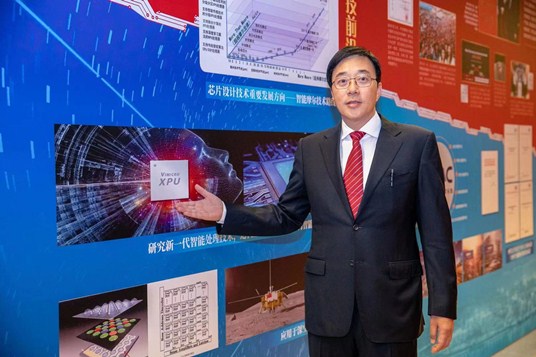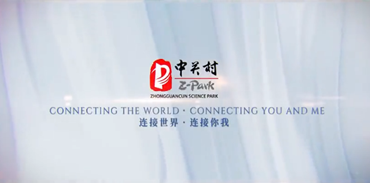Two-decade Innovation Achievements and Outlook Seminar held
A Seminar on Innovation Achievements and Outlook of the "Starlight Chinese Chip Project" during 1999-2019 was held on Dec 28, 2019 at the Great Hall of the People in Beijing. The seminar reviewed and summarized the independent innovation achievements of Chinese chips, and discussed their future development.
More than 30 leaders and academicians from government departments and industry associations including Han Qide, Vice Chairman of the 10th and 11th National People's Congress, and Zhang Yutai, former director of the Development Research Center of the State Council, attended the event.
Deng Zhonghan, academician of the Chinese Academy of Engineering, made a report on the achievements of Chinese chips in the past two decades, conferring awards on Yang Xiaodong and Jin Zhaowei, among others.

The Seminar on Innovation Achievements and Outlook of "Starlight Chinese Chip Project" was held on Dec 28, 2019. [Photo provided to chinadaily.com.cn]
Over the past two decades, China independently developed its first chip, improved the innovation system of the information industry, activated multiple related industries and application scenarios such as smart devices, smart cities, and the Internet of Things, and proposed Intelligent Moore.
In the past two decades, under the innovation mechanism of Silicon Valley and the whole nation system, innovative subjects led by enterprises formulated the national SVAC standards for public safety, made breakthroughs in 15 core chip design technologies and applied for more than 3,000 domestic and foreign technology patents, proposed Intelligent Moore and the XPU heterogeneous multi-core intelligent processor chip technology architecture, created a core technical team with more than 70 returned overseas professionals and introduced more than 2,000 outstanding talents from at home and abroad, and completed dozens of national major scientific and technological R & D and industrialization projects.

Deng Zhonghan, academician of the Chinese Academy of Engineering, delivers a speech during the meeting. [Photo provided to chinadaily.com.cn]
During the past 20 years, China independently developed the first chip
In 1999, with the support of the National Electronics Development Fund, Deng Zhonghan and a group of overseas doctoral entrepreneurs established Vimicro in Zhongguancun and the National Key Laboratory of "Digital Multimedia Chip Technology", engaging in the R & D, design and industrialization of ultra-large scale integrated circuit chips.
In 2001, China's first million-gate ultra-large-scale digital multimedia chip "Starlight No.1" was launched. In the following years, the series of chips were adopted by Apple, Samsung, and other well-known foreign brands, occupying more than 60% of the global PC image input chip market.
In 2005, Vimicro became the first domestic chip design company listed on the NASDAQ stock exchange. The National Electronics Development Fund, which gave support to Vimicro, received a 22-fold return from its original investment. Consequently, an innovative system including national engineering, national key laboratories, and national high-tech enterprises was formed

Deng Zhonghan introduces Vimicro, the first domestic chip design company listed on the NASDAQ stock market. [Photo provided to chinadaily.com.cn]
Explore smart cities
At present, many countries are actively exploring the underlying technology for the construction of smart cities; China is one of them. Therefore, the construction of smart cities has become the new goal of the "Starlight Chinese Core Project".
In recent years, China has become the first country in the world to issue technical standards in the field of video information security. Two generations of national SVAC standards for public safety have been formulated. Based on them China has become first in the world in adopting new technologies such as artificial intelligence and independently developed controllable chips, algorithms, equipment, and software. The national SVAC standards for public safety have played a key role in major projects such as the Skynet Project, the Xueliang Project, intelligent transportation, digital border defense, safe cities, and smart cities.
In addition, the world's first embedded neural processing unit (NPU) artificial intelligence chip --"Starlight Intelligent No.1" -- has been applied in the intelligent security system based on the national SVAC standards, and will be used in intelligent transportation and smart cities.
Explore development in the post-Moore's Law era
As Moore's Law is approaching its physical limits, heated discussions were held on the future development of the integrated circuit industry. Academician Deng Zhonghan believes: "At the physical level, the development of intelligent chips has been limited by physical laws. But technological innovation at the information level is far from ending."
In recent years, Intelligent Moore was proposed, which shifted from two-dimension to three-dimension and extended from the physical level to the signal level. Based on the mechanism of the human brain and the upgrading of algorithms and chip architecture, more intelligent calculations will be formed, further improving information processing capabilities.
Based on Intelligent Moore, the concept of a heterogeneous multi-core processor (XPU) was proposed, which combines CPU, GPU, NPU, DSP and other technologies to interactively process data at the bottom layer. XPU achieve deep-level fusion computing by sharing computing power and memory of different types of processor cores and improving systems' "performance / power consumption" ratio in practical applications, especially embedded applications.
The next research targets are the new generation of intelligent processing technology, multi-mode fusion computing architecture based on XPU, high-efficiency, high signal-to-noise multi-spectral signal compression and coding technology, video structuring technology, data security technology, and new generations of heterogeneous multi-core intelligent processors. Heterogeneous multi-core processors will be used in different application scenarios to screen and analyze data scenarios, process and analyze the data with the best data processing methods and calculate the results, so as to help decision-making and empower industry applications.
Over the next ten years 10 billion yuan will be invested in chip technology, system applications, machine-learning technology, and deep space detection and perception technology. Real-time multi-modal information processing technology and large-scale industrialization will lead to standard formulations.

